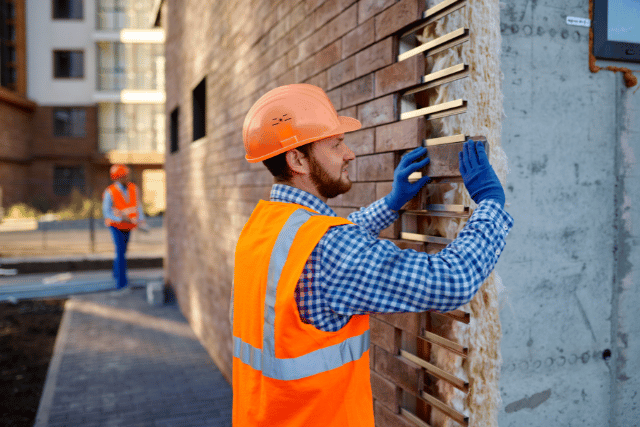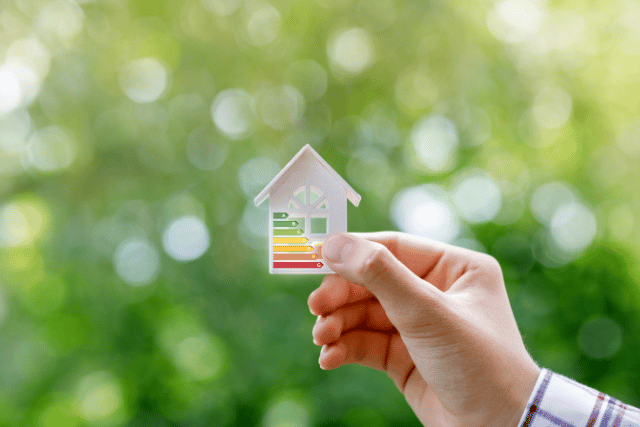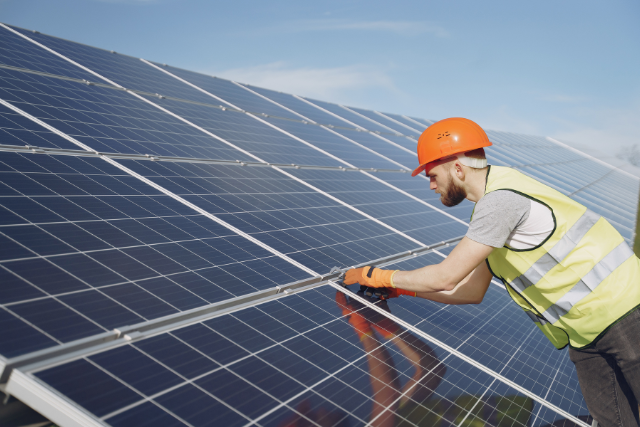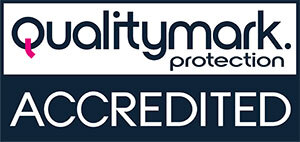Back Boiler Heater Systems
In the realm of home heating systems, back boilers have remained a popular choice for homeowners seeking efficient and space-saving solutions. However, understanding the intricacies of back boilers, including their functionality, advantages, and considerations, is essential for anyone considering this heating option.
In this article, we’ll answer what is a back boiler, what their pros and cons are, and how you could be eligible for a free boiler upgrade!

What Is A Back Boiler?
A back boiler is a type of heating system that’s built into a fireplace or stove. It’s called a “back” boiler because it sits behind the fire or stove, hidden from view. Instead of having a separate boiler unit like most heating systems, a back boiler uses the heat from the fire or stove to warm up water. This heated water is then circulated around the house to provide central heating and hot water for taps and showers.
A back boiler is a clever heating solution that combines efficiency with convenience. By harnessing the heat from a fireplace or stove, it provides both warmth and hot water for your home. It’s no wonder why many homeowners have used back boilers for many years – but is it the most efficient?
How Do Back Boilers Work?
Now, let’s break down how a back boiler works. A back boiler uses the heat generated from a fireplace or stove to warm up water, which is then used for central heating and hot water supply in a home. Here’s how it works:
Location: A back boiler is installed behind a fireplace or stove, hidden from view. It’s designed to fit snugly into the space, maximising efficiency and saving space in the home.
Heat Transfer: As the fire burns in the fireplace or stove, it generates heat. This heat is transferred to the back boiler, which contains a water-filled chamber. The heat from the fire warms up the water in the chamber, causing it to reach high temperatures.
Circulation: Once the water in the back boiler reaches the desired temperature, it is circulated through a network of pipes connected to radiators or underfloor heating systems throughout the house. This circulation system distributes the heated water evenly, providing warmth to different areas of the home.
Hot Water Supply: In addition to providing central heating, many back boiler systems also include a separate hot water cylinder. This cylinder stores hot water produced by the back boiler, ensuring a constant supply of hot water for bathing, washing dishes, and other household needs.
Control: The operation of a back boiler can be controlled using a thermostat or timer, allowing homeowners to adjust the temperature and timing of the heating system according to their preferences and schedule.
Are Back Boilers Now Illegal?
Yes, back boilers have been illegal to install since 2005. However, it is not illegal to have a back boiler in your home if it was installed before 2005.
Additionally, while existing back boiler systems may still be in use, homeowners should ensure that their systems comply with current safety standards and regulations. Regular maintenance and safety checks by qualified professionals are essential to ensure the safe operation of back boiler systems and to prevent potential hazards such as carbon monoxide leaks or chimney fires.
It’s important to consult with heating professionals or regulatory authorities in your region to stay informed about any legal requirements or restrictions regarding the installation and use of back boilers. Additionally, homeowners considering a new heating system may explore alternative options that offer improved efficiency, safety, and environmental sustainability.


Pros and Cons of Back Boilers
The pros:
Space-Saving Design: Back boilers are integrated into fireplaces or stoves, saving space in the home compared to standalone boiler units.
Versatility: Back boilers offer flexibility in fuel options, allowing homeowners to choose between wood-burning, gas, or electric fireplaces or stoves to suit their preferences and heating needs.
Central Heating and Hot Water: Back boilers provide both central heating and hot water supply, eliminating the need for separate heating systems and ensuring a constant supply of hot water for domestic use.
The Cons:
Safety Concerns: Improper installation or maintenance of back boilers can pose safety hazards such as carbon monoxide leaks or chimney fires. Regular safety checks by qualified professionals are essential to prevent accidents.
Maintenance Requirements: Back boilers require regular maintenance to ensure optimal performance and safety. Chimney inspections, servicing, and safety checks should be conducted by qualified professionals to prevent potential issues.
Outdated Technology: Compared to modern heating systems, back boilers may be considered outdated in terms of technology and efficiency. Homeowners may prefer newer, more advanced heating options with improved features and energy-saving capabilities.

Are Back Boilers Expensive To Run?
The running costs of back boilers can vary depending on several factors, including the efficiency of the system, fuel prices, insulation levels in the home, and usage patterns. Studies have shown that for every £1 you spend heating up a back boiler, 30p is wasted due to heat loss.
Here are some things that will determine the running costs of your back boiler:
- Efficiency: Older back boiler systems may have lower efficiency ratings compared to modern condensing boilers. If your back boiler is older or less efficient, it may be more expensive to run.
- Fuel Type: The type of fuel used in the back boiler can impact running costs. For example, wood-burning back boilers may have lower fuel costs compared to gas or electric-powered systems, depending on local fuel prices. However, it’s essential to consider the availability and sustainability of the chosen fuel type.
- Insulation: Well-insulated homes retain heat more effectively, reducing the need for continuous heating and lowering running costs. Proper insulation in walls, floors, and roofs can help improve the overall energy efficiency of the home and reduce heating bills, regardless of the heating system used.
- Maintenance: Regular maintenance of the back boiler, including servicing, cleaning, and safety checks, is essential for optimal performance and efficiency. Neglected or poorly maintained systems may experience reduced efficiency and higher running costs over time.

Want to learn more about the UK Government’s ECO4 Scheme? Check out our page dedicated to educating you about what you could be entitled to here.
Back Boiler Replacement Grants
Did you know that you could be eligible for a FREE back boiler replacement, paid for by the UK Government?
The back boiler replacement grant is a part of the government-backed ECO4 scheme to help homeowners or private tenants in low-income or benefit receiving households upgrade their old back boilers, to more modern and efficient gas combi condensing heating for their homes. The aim of back boiler replacement grants is to help improve the energy efficiency of people’s homes and reduce fuel poverty across the UK.
Check your eligibility:
- Property ownership: Homeowners or Private tenants
- Energy efficiency of the home: Your home will need a poor energy efficiency rating to qualify for a grant to install central heating. This can be an EPC (Energy Performance Certificate) of E, F, or G.
- Income: You will need to be in receipt of benefits or have a household income of less than £31,000 per year.
Conclusion
In conclusion, while back boilers offer certain advantages such as space-saving design and versatile fuel options, it’s crucial to acknowledge the potential drawbacks associated with these heating systems. Throughout this discussion, we’ve explored the importance of regular maintenance and safety checks to ensure the efficient and safe operation of back boilers.
Undoubtedly, back boilers can provide reliable central heating and hot water supply when properly installed, maintained, and operated. However, they can no longer be installed in UK homes, and those existing before 2005 need for meticulous maintenance. This means that many households are now choosing to upgrade their back boiler to a new gas combi boiler.
Check out if you’re eligible for a back boiler upgrade today.
See Our Other Blogs
How Much Does External Wall Insulation Cost?
External Wall Insulation has become a popular choice for homeowners to improve energy efficiency and reduce heating costs. Also referred to as solid wall insulation, it involves adding a layer of insulation material to the exterior walls of the building. This then acts like a thermal barrier, reducing heat loss through the walls. External wall insulation is key to lowering your energy bills.
How To Calculate Energy Efficiency
Energy efficiency is a measure of how effectively energy is utilised in a system or process to accomplish a specific task. It’s about getting the most out of the energy we use and optimising performance. Whether it’s in homes or businesses, understanding and improving energy efficiency are steps toward sustainability and resource conservation.
Solar PV has gained immense popularity as a clean and reliable energy source that holds the promise of reducing greenhouse gas emissions and minimising our dependence on fossil fuels. Photovoltaics (PV) has transformed the way we produce and consume electricity. Learn more about how solar pv can help save you money on your electricty bills.




